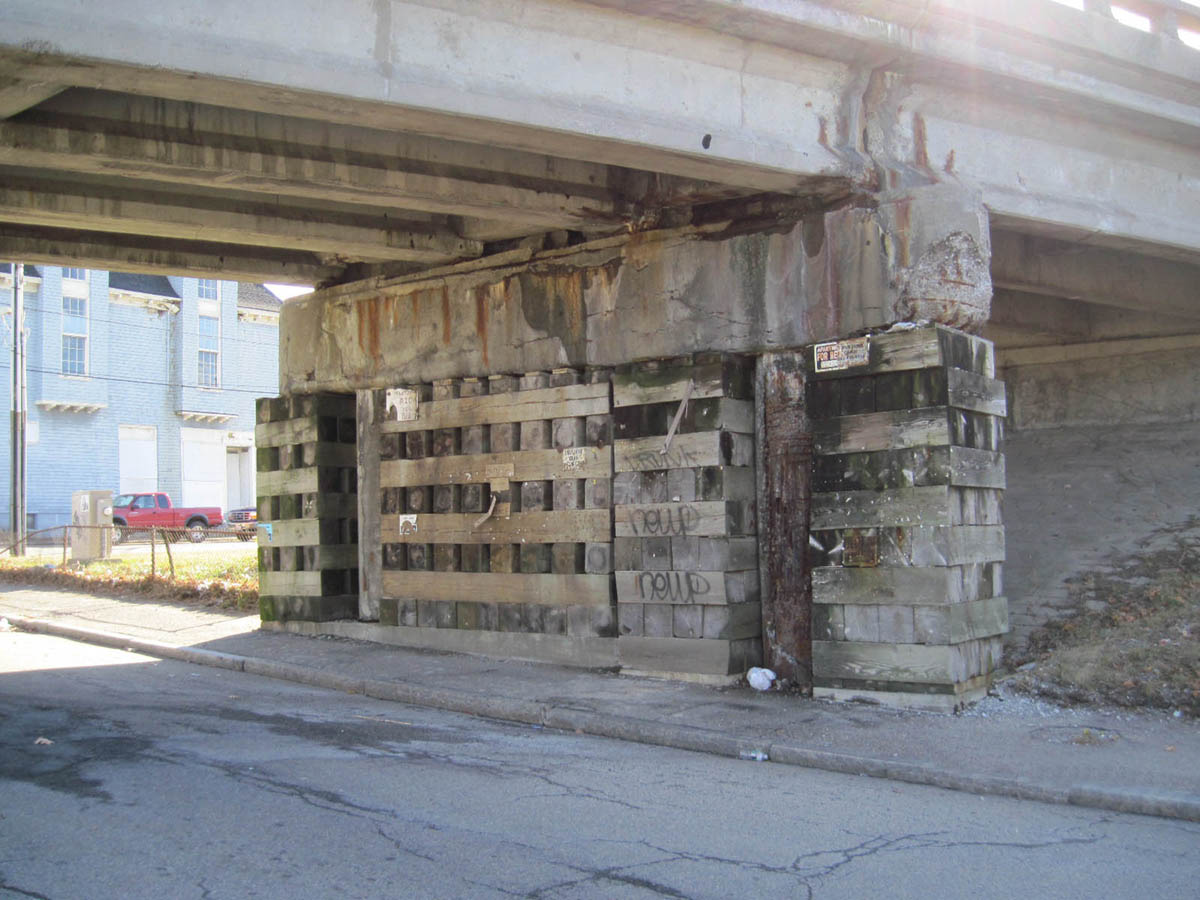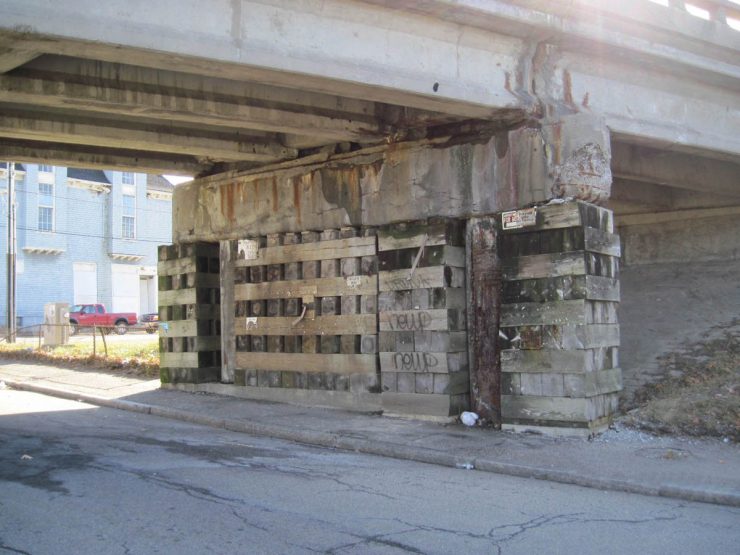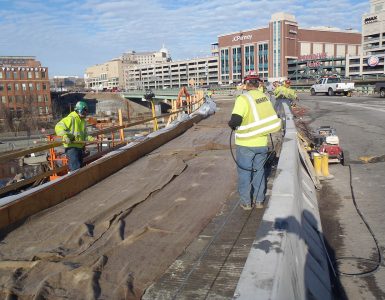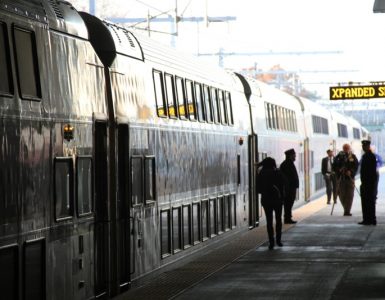
The crumbling Warren Avenue bridge in East Providence was recently replace. Image from RIDOT
[alert type=”warning”]Barry Schiller, a retired Rhode Island College math professor, is a long-time member of the State Planning Council’s Transportation Advisory Committee. He also was on the RIPTA Board of Directors 1995-1999.[/alert]What is your 10 year vision for transportation in Rhode Island? The Governor and her new RIDOT leaders propose their answer on the home page of the RIDOT website where there is a link to a 10 year $4.8 billion transportation plan called “Rhode Works.” This is about $1.1 billion more than current funding levels. A $700 million revenue bond is proposed for funding “replacement, reconstruction, and maintenance” of state bridges, the bond to be paid back by tolls on large commercial trucks crossing some bridges on Routes 95, 195, 295, 146, and 6/10. $400 million is set aside for the Route 6/10 bridges. There is a goal to reduce the percentage of our deficient bridges from about 22% to 10%. There will be a hearing on the proposed tolls at House Finance on Tuesday evening June 2.
Another $400 million to fund Rhode Works is from seeking $400 million in federal “New Start” transit funds. Rhode Works promises a “new commitment to provide increased bus and rail services.” The only specific transit project mentioned is an express bus lane on Routes 6/10. Rhode Works also promises “funding for bike lanes and accessible sidewalks.” There is no mention of bike paths.
Because of the pushback from the anti-tax and trucking interests, the Governor’s office has reached out to transportation advocates for support. On a conference call, they promised that if the truck tolls go through, an additional $80 million will be available for unspecified transit projects, and promised some public input as to how they would be used. They also said the Route 6/10 project could cost as much as $800 million, (even more than the I-195 Iway relocation) and consideration would be given to all designs.
Not everyone was convinced. Some leaders of the RI Bicycle Coalition and the RIPTA Riders Alliance were dubious. There are many questions. They include the actual toll policy, implementation costs, whether new tolls on the interstates would be allowed, whether RI truckers can get a special break, the role of public input, why we are bonding instead of a pay-as-you-go system that reduces finance costs, and the role of the bus hub money that voters approved.
I for one also question the proposed bus lane on 6/10 – as far as I know it was not previously on anyone’s wish list. During the 7am to 9am peak when it could be useful (and not even all of that time) currently about 13 buses (from lines 9 Pascoag, 10 Scituate, 21 Garden City, and 30 Oaklawn) use part of the 6/10 corridor to come into Providence, about once every 10 minutes. This hardly justifies a bus lane, even if you add in a few possible South County buses using a longer route to avoid I-95 congestion. Perhaps RIPTA can explain how they can make better use of such a bus lane, though I’d want to ensure it doesn’t come at the expense of other service, but as of now it seems the bus lane may be an excuse to gather lots of Federal transit funds to help pay for a very large route 6/10 highway project.
Rhode Works says nothing about any transit goals, RIPTA operating deficits, overcrowded buses, the bus hub money the voters approved, the need for more shelters, bus stop snow removal, speeding up more routes with green light extenders, the Pawtucket train station, the streetcar, or promise even a mile of bike paths.
All this bears watching, not much is fleshed out beyond the enabling of the tolls. I think our state does need the revenue from the tolls to fix our bridges and asking trucks to pay more seems fair since they do most of the damage. But despite some kind words for transit, with so few commitments to any real transit improvements beyond the Route 6/10 bus lane that might do little good, and with little public input into the process so far, I recommend remaining skeptical about the overall Rhode Works program for now.






This current administration on capitol hill has ignored talking about sustainable transportation for too long. You can’t just ignore the fact that car oriented transportation policy fails us all. A proposed bus lane on 6/10 is not thinking towards the future. The 6/10 connector doesn’t have a future. It’s not cost effective to replace it. It’s better to make the 6/10 connector land into a transit paradise.
Why a bus lane and not an HOV lane?
Mr Schiller mentions something that I’ve been wondering: the last time tolls were proposed for our roads, I remember it bring said that the federal DOT absolutely wouldn’t allow new tolls on existing interstates. This was only a few years ago. Has their position changed so dramatically?
The feds would not let us toll the interstates, there’s a loophole that allows us to toll bridges.
This is a developing story.
The Senate Finance Committee has also posted a hearing on the budget article to enable the tolls on Thursday June 4 at 2pm.
The Coalition for Transportation Choices has distributed an e-mail from the Governor’s Office indicating in writing that if they get the tolls or equivalent, Rhode Works would indeed budget $80 million for unspecified transit projects (over the 10 years) and also $128 million for “bike/ADA” projects. It also clarifies that the wished-for $400 million Federal Transit New Starts would be for the bus lane on 6/10, that is in addition to the $400 million for 6/10 from the bridge program. That lane might indeed become a HOV lane to generate enough (legal) usage.
So a bus lane is half the cost of the entire 6/10 rebuild? That’s must be one fancy fucking bus lane.
The bus lanes make no sense because they pass over all the dense neighborhoods they would serve, where the ridership is.
They won’t create development next to them, or serve existing development with a pedestrian environment.
And even if we could convince RIPTA to get on and off for service to these neighborhoods, that would obviate the bus lanes’ advantage, as anyone who’s been in an HOV lane can tell that highway bus/HOV lanes lose a lot of their advantage each time you have to re-merge with all the other traffic (which doesn’t yield).
So we should try to get bus lanes as part of a boulevard, and not just transit oriented decoration, which is what this proposal is.
I tweeted the @FTA_DOT account to ask that they not grant funding for a project like this. I certainly feel like the transit aspect is there just to get more funding for the highway, and not the other way around.
Voters from Johnston and Warwick don’t want to share buses with the unwashed masses of Providence. So we should build them a $400 million bus lane in the sky.
RIPTA seems to be functionally useless for anything but getting into and out of Providence. How many revamps of Kennedy Plaza have been done in the last ten years? Have they made any difference for making RIPTA more useful? Can I go from Woonsocket to Smithfield without going through Kennedy Plaza?
I live in one part of the state and work in another, both outside of Providence. Using mass transit would quadruple my commute compared to just driving. Has any work been put into analyzing where the largest employers in the state are located and figuring out how to get their employees to use mass transit? Looking at the (out of date) system map on RIPTA’s web site, it looks like Northern RI and western South County have almost no bus service at all.
Fixing our roads and bridges and charging tolls for heavy users are interesting ideas, but what about making mass transit practical enough for the average Rhode Islander to leave their car at home at least part of the week? By practical, I mean that the commute via public transportation would be no more than 10% slower than it would be to drive; I might even give 20%. That would save wear and tear on our roads and improve our air quality.
If someone in Foster could hop on mass transit and be at a beach in Westerly in about the same amount of time it takes to drive there, that would save a lot of parking space and relieve seasonal congestion. If people visiting bars and restaurants in Providence or Newport could hop on a convenient transportation system that would get drunks off the road and improve safety, not to mention boost revenue for our hospitality industry.
The whole state of Rhode Island is about the size of metropolitan NYC. Having a state-wide subway or light rail system seems like it would be feasible and useful. What’s the possibility of doing something like that?
So what qualifies as a bridge? Any overpass?
6/10 could cost $800 million!!!?? That’s absolutely absurd. Who the hell could think it’s so vital for the economy?
And the bus lane in the sky is just insulting.
I’m not thrilled with the initial thoughts on transit that are coming out connected to this project. However, I want to point out that with no design work being done yet and everything starting from scratch with that stuff, I’m not sure that this is a lost cause. There’s a lot of reasons to spend $800M revitalizing the 6/10 connector and adjacent area with transit components.
There’s no reason to rebuild it as it exists and just throw an express lane on it.
So given that I personally think the tolls are a great idea, I think that investing heavily on doing the RIGHT thing for the 6/10 connector makes a lot of sense, I have to wonder what’s the best way we can influence this process?
My initial thought is we should ensure that RIDOT is not the only party with a formal, decision making role on the 6/10 redesign. We should ensure that Providence Planning, RIPTA, and residents have a formal role to heavily influence, and possibly even veto RIDOT designs. We should be sure that the design goals and principals are not set by highway builders and engineers extraordinaire but instead by folks who are thinking about the right way to plan and rebuild that corridor.
Imagine what $800M can accomplish if it’s directed toward making 6/10 a boulevard and doing a complete transit solution with real development opportunity all along the existing alignment. We should keep and support the tolls and the spending for this part of the city and push to make sure the design and follow through are done right.
300 buses a day inch through Olneyville Square. That is where bus lanes are needed.
Does “Rhode works” have any studies to exemplify the economic impact of route 6/10? What is the state really gaining from this 800 million dollar investment?
I’m in favor of a boulevard over a replacement highway. Transportation aside from what I understand the overall strategy of the governor seems to be pushing for the maximum amount of job creation, no matter where it might happen in the state. By combining a highway with mass transit along with the dollars that would bring in, more jobs would be created by adding BRT than just a highway or a boulevard.
What needs to be compared is the job creation for a highway vs. a boulevard, both with a mass transit component. Also, the development potential and long-term permanent job creation of the two should be analyzed.
Another cost analysis might be to compare BRT with LRT (Light Rail Transit). As was demonstrated in Hartford the construction of a BRT route is no cheaper than constructing LRT. Before Portland built its light rail system the city was seriously considering buses instead.
When Portland compared the two modes for immediate capital costs LRT was higher than BRT. They looked at costs over a 20-year period, LRT was actually cheaper, as LRT vehicles have a greater capacity, require less operators (salaries) to move the same number of passengers, LRT vehicles last much longer than buses (25-35 years vs. 12-14 years respectively) and require far less maintenance because LRT uses track instead of bumpy roads and use electric motors that are more long-lasting than diesel.
As Jason pointed out the BRT lane isn’t designed yet. Whether it’s a highway or boulevard, if the BRT starts at a parking lot at 295, there’s no reason why stations couldn’t be built along the route to Olneyville Square and Downtown. Possible stations could be Hartford Av (Johnston), Killingly St, Olneyville Square West, Broadway-Westminster, Atwells Av-Eagle Sq, and Dean St. All stations would or should be fed by bus routes.
The suburban catchment area for a “295 to 6/10 to Downtown” BRT is roughly 170,000 people. That includes western Cranston, Johnston, Smithfield, Centerdale(NP), the Rhode Island towns west and the four closest Connecticut towns. And yes, people from that part of CT commute to Rhode Island and to Providence.
If the four westernmost Providence neighborhoods are included that would add roughly another 30,000 people for a total of 200,000.
If just 0.25% of that population used BRT to get to Downtown Providence that would be 5,000 passengers one-way per day.
Grow Smart statement about Governor’s user fee proposal: http://bit.ly/1IcPEoF
So what would the boulevard actually look like? I saw the RIFuture post with different examples, but none of those had busy train tracks on one side and a 3 story cliff on the other.
Would it all be raised to be the same height as federal hill? More crossings? What could prevent it from just being an unofficial highway, where cars go 40+mph? Would it be of any use to pedestrians or bikers? I mean, is there anything this can do that fixing up Harris ave couldn’t?
When you say “boulevard” are you picturing something like blackstone boulevard? Or memorial boulevard? How could memorial boulevard be incorporated into the design? How would it affect the memorial/francis intersection? Olneyville square? Dean Street? The 95 Atwell’s/Broadway exits? That huge exit just north of Spruce st?
When you look at the map, removing the 6/10 looks like it could be bigger in scale than moving the rivers or 195. And there’s lots of ways to screw it up. For example, we could end up with just a longer, faster memorial boulevard.
There’s so many options, and it affects so much of the city.
Working to eliminate the 6/10 connector is a noble goal, but I agree with person’s point above me.
We saw up in Boston at the conclusion of the Big Dig that what replaced the central artery on the surface was a “greenway” surrounded on all sides by a six-lane drag strip – essentially a surface freeway.
New Haven’s grand designs on removing the awful CT-34 freeway didn’t take long at all to mutate into plans for a drag strip ‘boulevard’ where pedestrians are fenced off so that the cars can still go fast.
It’s vital that we ensure that whatever replaces 6/10 isn’t worse than what we’ve got now, and with a number of examples of elevated freeways being traded for de facto surface freeways, worse is a very real possibility here.
This post at I Ride The Harlem Line shows a temporary station on MetroNorth in Connecticut. It is simply a raised platform built of wooden (or maybe it is a composite material) planks.
An Olneyville Station doesn’t really need to be too much more than this. A permanent station would feature more robust materials. Sheltered waiting areas are needed. But an Olneyville (or Pawtucket or Cranston…) station need not be a $200 million project like Wickford Junction, it actually should not be that at all.
Jef, This is exactly how the state could create train stations cheaply and quickly.
Rhode Island needs an instant instate rail system The current two stations south of Providence with the massive schedule gaps don’t really constitute a system.
When Connecticut started Shoreline East the state opened a half dozen new stations all at once. Timetables were coordinated with New Haven business hours and transfers to Metro North trains to New York.
Rhode Island should be no different than Connecticut.
Stop MBTA trains in Providence. Run a small Rhode Island Local Shuttle Train, with one or two cars back and forth, from South County on regular headways that coordinate Providence with business hours and transfers to MBTA trains to Boston. This would also help the airport.
Couldn’t agree more. Small bare bones RI rail stops in locations like East Greenwich, Olneyville, Pawtucket, Valley Falls/CF, etc. with just covered platforms. I don’t need anything fancy. There should be ZipCar stations and daily bike rental kiosks co-located at all these facilities. Tickets/day passes purchased electronically on cell phone applications. Make it easy for people to live in the City and come out for the day. It will have the reverse effect of increasing urban residents and decreasing car ownership.
Why do I have to drive to East Greenwich from Providence to have dinner? I’d gladly pay a fare to leave the City after work and come back at like 10/11 at night. On weekends, service should run until the bars get out between E.G., Warwick, Pawtucket, and Providence —- at the very least. There should be some kind of service between Providence and Newport during the high season, as well, more likely by boat. A service like that increases mobility and makes people feel like they have more options when they live in Providence.
Additionally, the added benefit of running more trains into/out of Providence Station is a pretty cool proposition. Seeing people coming and going from different parts of our own state, instead of from Massachusetts or further away via Amtrak, would put us on the right track to being an example of successful mass transit decisions in New England.
I know I will offend some people with this, but, the short sighted decision to pave over rail paths like the East Bay bike path was an idea that will likely come back to haunt them. An East Bay to Newport and Cape Cod connection would be an excellent compliment to a RI rail system. Maybe it can be done on other freight tracks instead, I don’t know. I love the East Bay bike path, but I’d prefer easy access to Newport via rail 12 months a year.
Lastly, and sadly, I think a RI Rail project would have just as many haters as the streetcar project. People would say that the MBTA already exists. There needs to be demonstrable benefits, for a reasonable price tag, otherwise the comment section trolls will control the discussion and calls of “38 Railroad” will be made. I already want to throw up at the thought of having to read that in comments.
KCB,
Bristol county would be way too complex and challenging for too little return. Multiple bridges, flood zones, not that dense, circuitous paths, etc. The residents near the rails (even the poor/middle class) wouldn’t see too many benefits, and would fight it hard. The 60 is convenient for them already. I doubt we’ll regret getting rid of that old rail.
The narrow EP->newport corridor is actually served pretty well by the 60. The 60 would be one of the best RIPTA routes to invest in, though. Make it faster, less crowded, more attractive. It would greatly benefit both commuters and tourists, low and high income, AND people doing local trips without the car.
If bristol and newport county are to get any more transit options, I think ferries would be the way to go (Bristol -> Warwick in 15 minutes? Newport -> Providence in 40 min?). maybe.
I’ve thought about it on many a 60 trip.
And does anyone else find it ridiculous the RIPTA has no service to Fall River? It’s on our border. It’s in the providence Metro. There is a ton of economic activity between the two… it’s a no brainer.
Person, What odd to me is that Fish Rd Park & Ride goes to Tiverton, which is really close to Fall River. It wouldn’t take much effort to bring it to fall river but I think a 3 stop light rail line that would stop in Fall River, New Bedford and Providence would be a better idea.
For now RIPTA should focus on making it’s current routes faster and more frequent and cooperating with local planning departments on making the area surrounding bus stops more walkable and bike friendly (basically more people-centric). Transit thrives in walkable places.
What I think would be best is: Make a 60 branch go Providence->195->Fall River->Tiverton->Newport.
That would make FR –> Providence bus service just as fast as driving. I bet it would entice a fair number of commuters, AND provide opportunities for a lot of people with no way to get to providence. It makes perfect sense.
Plus, it *might* shave 10 or so minutes off the Providence-> Newport trip.
RINPR: Mattiello Slams Brakes on Raimondo’s Truck Toll Plan
Not for nothing, but this is actually a thing they do in almost every other state on the eastern seaboard. Someone up on Smith Hill could call any number of other states and ask them how they do it.
Until RI decides to make a continuous bike net over bridges and through Providence, which connects all 100 miles of existing bikeways and other marginally useful road net, they remain in violation of Code of Federal Regulations, FWHWA mandates, and own state’s guidelines. Too bad they can freely disobey laws, because there’s nobody to prosecute except taxpayers who foot any fines or shortcomings in funding that this causes.
It is truly criminal how bike lanes suddenly end, crosswalks aren’t repainted or just omitted, and sidewalks not only don’t meet ADA compliance they are strewn with debris when, in fact, they exist alongside roads where they supposed to be. I hope some of that $4.8 billion is to provide bike-ped bridge crossings, or nearby alternative. Cyclists had to divert miles out of their way over the Henderson for the last several years, and still have to detour 75 miles around Narragansett Bay because state does accommodate them across Jamestown. And when they detour, they get Point Street traffic without a bike lane.